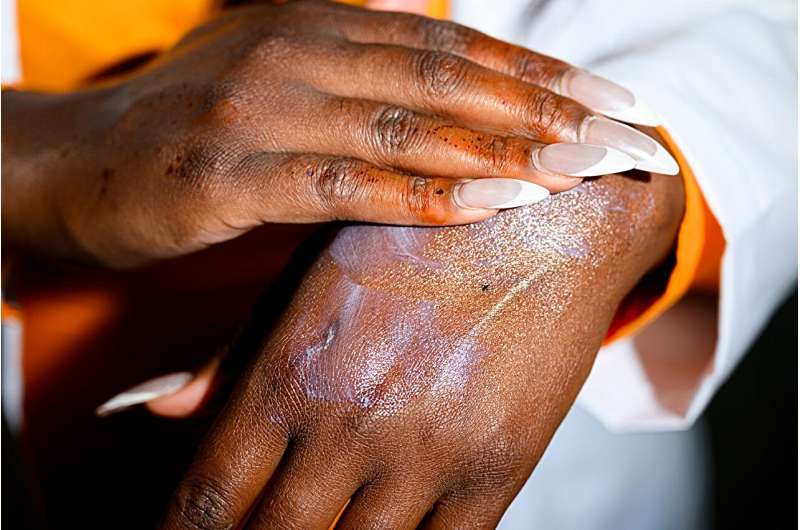
As a doctoral student, Camille Martin was “the first to show that these small molecules inside the skin of cephalopods… also have very interesting antioxidant properties,” in addition to protecting against sun exposure, says Leila Deravi, a professor of chemistry at Northeastern University. Credit: Matthew Modoono/Northeastern University
When Northeastern graduate Camille Martin and associate professor Leila Deravi co-founded Seaspire, a skin-care ingredient company inspired by the pigments of octopus and squid, their goal was to create a product that was good for your skin and the environment.
New research shows they are on the right track.
An article published in the International Journal of Cosmetic Sciences claims that xanthochrome, a synthesized version of a molecule found in cephalopods such as squid, octopus and cuttlefish, increases sunscreen levels in combination with zinc oxide without having adverse effects on coral cuttings.
The marine safety survey results are important because “(traditional) UV filters in sunscreens have many toxicities,” said Deravi, Seaspire’s scientific advisor and associate professor of chemistry and chemical biology.
“Certain chemical UV filters in particular are known to create reactive oxygen species that are not only bad for the environment, but can also leach into our skin and cause systemic toxicities,” she explains.
The result is a pressing need for environmentally friendly ingredients, says Martin, who earned his doctorate in chemistry from Northeastern in 2019 and has been Seaspire’s CEO since its founding that year.
“The industry is very excited about new materials innovations,” she says. “As a biotech company, everything we do is focused on harnessing marine animals as inspiration for the next generation of skin care ingredients.”
From the laboratory to the market
Seaspire’s goal, Martin explains, is to make xanthochrome accessible to skin care manufacturers and distributors throughout the supply chain so that it can be found in a wide range of skin care and personal care products, including sunscreens, anti-aging applications and functional color cosmetics.
“We are currently completing research and development and are actively seeking partnerships to commercialize it,” Deravi says.
Produced as a brown, textured powder, xanthochrome has powerful antioxidant and skin-repairing properties, as well as light-diffusing qualities that offer protection against photoaging, Martin and Deravi say.
Martin explains that xanthochrome is the trade name for a chemically synthesized version of xanthomatin, which is found in the skin of cuttlefish, octopus and squid, as well as in insects.
“The secret to cephalopods’ unique coloration comes from its multifunctional chemical compounds, which we identified in our lab at Northeastern,” Deravi says.
“Camille’s doctoral work was the first to show that these small molecules present inside the skin of cephalopods, which contribute to the animal’s camouflage, also have really interesting antioxidant properties,” explains Deravi.
“They are free radical scavengers, which are very important for skin health and skin barrier function,” she explains.
“They also have very important optical properties that protect against sun exposure, which is the main function of some UV filters and sunscreens,” Deravi explains.
“We didn’t create a new molecule,” Martin explains. “We managed to isolate and characterize the properties of biomolecules present in cephalopods, design a bioidentical version of the natural substance, and position xanthochrome as a new active ingredient with a broad range of benefits for the skin.”
“It’s a really interesting space where a single molecule can have many functions,” she says.
Previous research has shown that xanthochrome, unlike parabens often found in sunscreens, is not an endocrine disruptor.
The most recent study shows that it increases the ultraviolet protection of zinc oxide, which the U.S. Food and Drug Administration considers a safe and effective ingredient in sunscreens, by 28 percent and its visible light blocking potential by 45 percent.
The study also showed that xanthochrome had no adverse effects on coral cuttings, even at concentrations five times higher than those used in conventional formulations.
Martin and Deravi hope skin-care manufacturers will see xanthochrome as a next-generation ingredient, following retinoids, vitamin C and hyaluronic acid.
“We’re creating products that can actually be applied and adopted by a wide range of users,” Martin says. “We’re creating something that’s not only safe for everyone, but also safe for the environment.”
“It is necessary to prove that the new raw materials are safe for humans and also for the ocean, where, ultimately, each product will end up being dumped,” explains Deravi.
More information:
Leila F. Deravi et al., Using cephalopod-inspired chemistry to extend long-wavelength ultraviolet and visible light protection of mineral sunscreens, International Journal of Cosmetic Sciences (2024). DOI: 10.1111/ics.12993
Provided by Northeastern University
This story is republished with kind permission from Northeastern Global News news.northeastern.edu.
Quote:Octopus and squid pigments improve sunscreen without harming the environment, researchers say (2024, July 22) retrieved July 24, 2024 from https://phys.org/news/2024-07-octopus-squid-pigments-sunscreen-environment.html
This document is subject to copyright. Apart from any fair dealing for the purpose of private study or research, no part may be reproduced without written permission. The content is provided for informational purposes only.